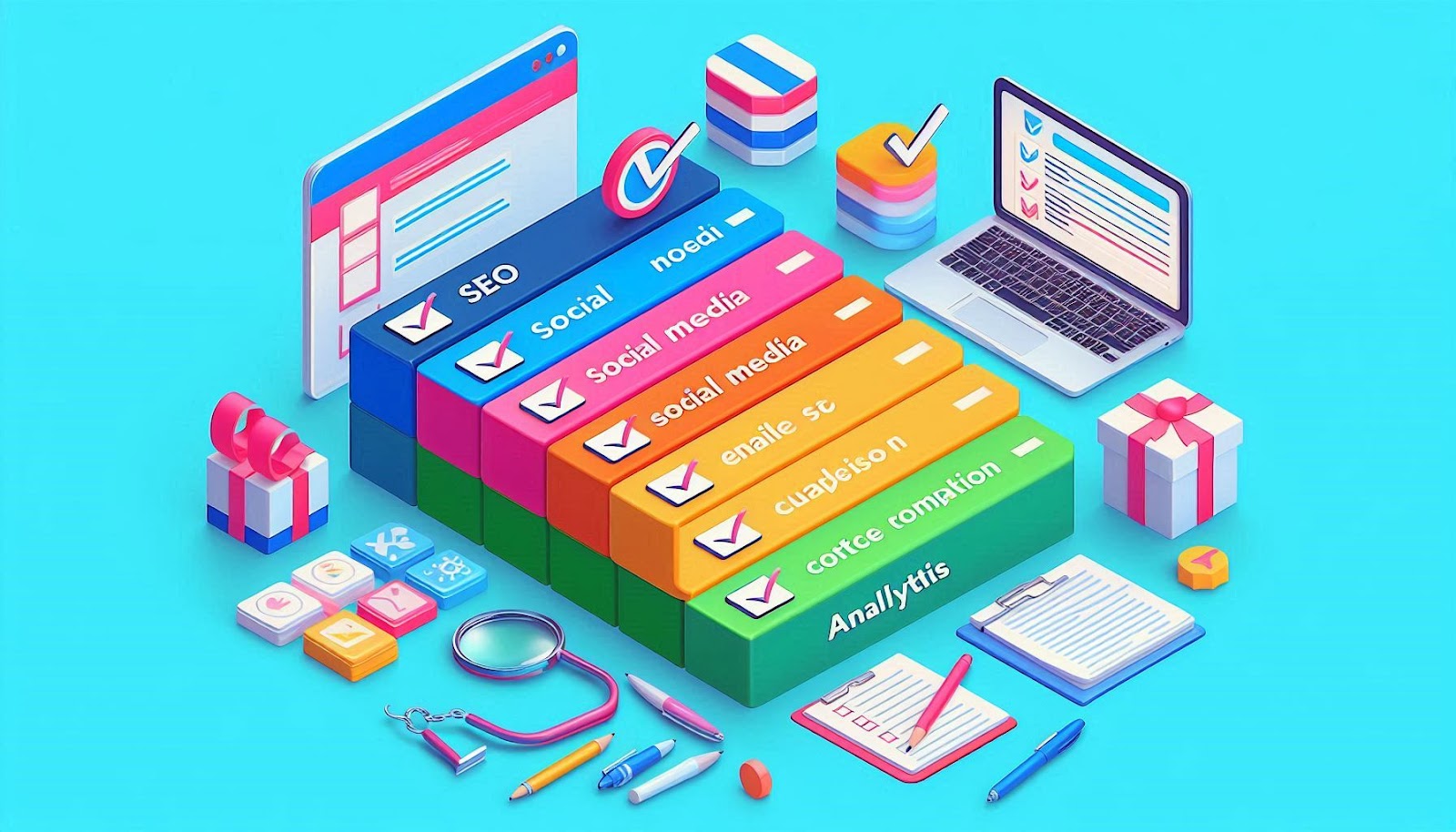1. Establish Goals and Objectives
- Define clear and measurable goals (e.g., increase traffic, generate leads, boost sales).
- Set specific KPIs (Key Performance Indicators) for each marketing goal.
- Align marketing objectives with overall business goals.
2. Target Audience Identification
- Buyer Persona: Create detailed profiles for your ideal customers, including demographics, behaviors, and pain points.
- Audience Segmentation: Segment your audience based on behavior, preferences, or purchase history.
- Customer Journey Mapping: Understand your audience's buying journey, from awareness to conversion.
3. Website Optimization
- SEO:
- Optimize meta titles, descriptions, headers, and image alt texts.
- Use relevant keywords throughout your content.
- Ensure website speed and mobile-friendliness.
- Implement internal and external linking strategies.
- User Experience (UX):
- Simplify navigation and ensure a smooth user experience.
- Ensure all CTAs (Call-to-Actions) are visible and functional.
- Test for responsiveness on mobile, tablet, and desktop devices.
4. Content Marketing
- Content Strategy:
- Plan a content calendar with blog posts, videos, infographics, and social media updates.
- Create evergreen content that provides long-term value.
- Use a mix of long-form and short-form content for varied audience needs.
- Content Creation:
- Ensure content is valuable, relevant, and solves audience problems.
- Optimize content for SEO with keywords, meta descriptions, and formatting.
- Content Distribution:
- Share content across multiple channels (social media, email, website).
- Repurpose content into different formats (e.g., blog to infographic).
- Collaborate with influencers, bloggers, and partners to expand reach.
5. Social Media Marketing
- Platform Selection:
- Focus on platforms where your audience is most active (e.g., Instagram, LinkedIn, Facebook).
- Content Posting:
- Post consistently according to the platform's best practices.
- Use engaging visuals, videos, and stories to increase interaction.
- Engagement:
- Respond to comments and messages promptly.
- Host live events, Q&A sessions, or polls to foster engagement.
- Advertising:
- Use targeted ads to reach specific audience segments.
- A/B test ads for better performance (test visuals, copy, CTA).
6. Email Marketing
- List Building:
- Grow your email list through lead magnets like free guides, trials, or newsletters.
- Ensure sign-up forms are easy to access on your website and social platforms.
- Email Campaigns:
- Segment email lists based on user behavior (e.g., new leads, existing customers).
- Personalize email content with dynamic content and user-specific recommendations.
- Use clear and enticing CTAs to drive action.
- Automation:
- Set up automated email sequences for new subscribers (welcome emails, onboarding).
- Use triggered emails for events like abandoned carts or product recommendations.
- Analytics:
- Monitor open rates, click-through rates, and conversion rates to optimize campaigns.
7. Search Engine Marketing (SEM)
- Google Ads:
- Conduct keyword research to select relevant and high-intent keywords.
- Use a mix of broad match, exact match, and phrase match keywords.
- A/B test ad copy and landing pages for higher conversions.
- Optimize bidding strategies based on campaign goals (e.g., CPC, CPM, CPA).
- Retargeting:
- Implement retargeting ads for users who visited your website but didn’t convert.
- Create custom audiences for more precise targeting.
8. Paid Social Advertising
- Budget Allocation:
- Set daily or campaign-level budgets based on goals and platform.
- Allocate budget towards the most effective campaigns.
- Targeting:
- Use detailed audience targeting (age, gender, interests, behaviors).
- Utilize custom audiences (e.g., retarget website visitors, lookalike audiences).
- Creative Testing:
- Test different ad formats (carousel, video, single image).
- Optimize for mobile, ensuring ads are visually appealing and CTA buttons are clear.
- Analytics:
- Track performance metrics like CTR (click-through rate), CPC (cost per click), and ROAS (return on ad spend).
9. Analytics and Tracking
- Google Analytics:
- Set up Google Analytics for website performance tracking (traffic sources, bounce rates, etc.).
- Use UTM parameters to track the performance of campaigns across different channels.
- Set up conversion goals to monitor lead generation and sales.
- A/B Testing:
- Continuously test landing pages, ads, and email campaigns to optimize performance.
- Analyze test results and make data-driven adjustments.
- CRM Systems:
- Integrate CRM (Customer Relationship Management) systems to track leads, sales, and customer interactions.
- Use insights to personalize future marketing campaigns and customer experiences.
10. Conversion Rate Optimization (CRO)
- Landing Pages:
- Ensure landing pages are optimized for conversions with clear messaging, visuals, and CTAs.
- Test different variations (headlines, forms, offers) to see which performs best.
- Lead Capture:
- Use pop-ups, exit-intent, and lead forms to capture visitor information.
- Reduce form fields to encourage more sign-ups.
- Analytics:
- Monitor user behavior with heatmaps, session recordings, and conversion paths.
11. Affiliate and Influencer Marketing
- Affiliate Programs:
- Set up an affiliate marketing program to increase brand reach and sales.
- Provide affiliates with custom links or discount codes to track conversions.
- Influencer Partnerships:
- Collaborate with influencers in your industry to promote your brand/products.
- Provide clear guidelines and incentives for influencers to share authentic content.
12. Local SEO
- Google My Business:
- Ensure your Google My Business profile is complete and optimized with accurate business information, hours, and photos.
- Local Listings:
- List your business on relevant local directories and ensure NAP (Name, Address, Phone Number) consistency across all platforms.
- Reviews:
- Encourage satisfied customers to leave reviews on Google, Yelp, and other platforms.
- Respond to reviews promptly to show customer care.
13. Budgeting and ROI Measurement
- Budget Planning:
- Allocate your marketing budget based on your overall strategy, focusing on high-performing channels.
- ROI Calculation:
- Use tools and metrics (e.g., conversion rates, customer acquisition costs) to track ROI for each marketing channel.
- Optimization:
- Adjust spending based on the performance of your campaigns. Reallocate budget from underperforming channels to more successful ones.
By following this Digital Marketing Checklist, you'll ensure your strategies are comprehensive, well-executed, and optimized for success across various digital channels.











0 Comments